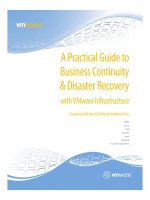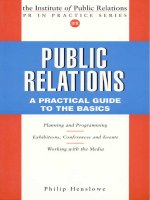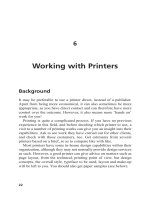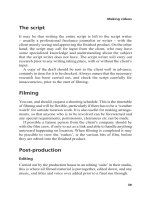A Practical Guide to BUSINESS WRITING: Writing in English for non-native speakers pdf
Bạn đang xem bản rút gọn của tài liệu. Xem và tải ngay bản đầy đủ của tài liệu tại đây (13.96 MB, 170 trang )
“Exciting, informative, directional, and extremely helpful are just some
of the words to describe A Practical Guide to Business Writing.”
Dr. Clarence Emslie, Senior English Language Teacher, Saudi
Development and Training, Kingdom of Saudi Arabia
“This book is a wealth of practical information for any person who must
produce short eective documents within the work environment of
the early 21
st
century.”
Michael Doherty, Director of Professional Communication
Services, United Kingdom
“This book is an indispensable aid to anyone wishing to improve his or
her performance in the workplace. A must for the serious student of
business English and a great guide for those wishing to hone their
business writing skills to perfection.”
Peter Hardcastle, Curriculum & Assessment Advisor, ADNOC
Technical Institute, United Arab Emirates
© 2013 Khaled Mohamed Al Maskari
Cover design by Parent Design (www.parentdesign.co.uk)
Registered oce
John Wiley and Sons Ltd, The Atrium, Southern Gate, Chichester, West Sussex, PO19 8SQ,
United Kingdom
For details of our global editorial oces, for customer services and for information about how
to apply for permission to reuse the copyright material in this book please see our website at
www.wiley.com.
The right of the author to be identied as the author of this work has been asserted in
accordance with the Copyright, Designs and Patents Act 1988.
All rights reserved. No part of this publication may be reproduced, stored in a retrieval system,
or transmitted, in any form or by any means, electronic, mechanical, photocopying, recording
or otherwise, except as permitted by the UK Copyright, Designs and Patents Act 1988, without
the prior permission of the publisher.
Wiley publishes in a variety of print and electronic formats and by print-on-demand. Some
material included with standard print versions of this book may not be included in e-books or
in print-on-demand. If this book refers to media such as a CD or DVD that is not included in the
version you purchased, you may download this material at . For
more information about Wiley products, visit www.wiley.com.
Designations used by companies to distinguish their products are often claimed as trademarks.
All brand names and product names used in this book and on its cover are trade names,
service marks, trademarks or registered trademarks of their respective owners. The publisher
and the book are not associated with any product or vendor mentioned in this book. None of
the companies referenced within the book have endorsed the book.
Limit of Liability/Disclaimer of Warranty: While the publisher and author have used their best
eorts in preparing this book, they make no representations or warranties with respect to the
accuracy or completeness of the contents of this book and specically disclaim any implied
warranties of merchantability or tness for a particular purpose. It is sold on the understanding
that the publisher is not engaged in rendering professional services and neither the publisher
nor the author shall be liable for damages arising herefrom. If professional advice or other
expert assistance is required, the services of a competent professional should be sought.
Library of Congress Cataloging-in-Publication Data is available
A catalogue record for this book is available from the British Library.
ISBN 978-1-118-41081-3 (pbk) ISBN 978-1-118-41078-3 (ebk)
ISBN 978-1-118-41079-0 (ebk) ISBN 978-1-118-41077-6 (ebk)
Set in 11/14 pt Myriad Pro by Toppan Best-set Premedia Limited
Printed in Great Britain by TJ International Ltd, Padstow, Cornwall, UK
A Practical Guide to
BUSINESS WRITING
Writing in English for non-native speakers
Khaled Mohamed Al Maskari
About the Author vi
Foreword by Dr. Clarence Emslie viii
Preface by Michael Doherty x
Introduction xii
What Does this Book Cover? xiv
Chapter 1 Business Writing Style 1
1. Keep your purpose, readers and content in mind 4
2. Keep your sentences short 5
3. Use positive language 7
4. Use linking words 9
5. Use simple, familiar words 13
6. Use the passive voice for specic reasons 18
7. Use bullet points and numbered lists correctly 20
8. Use tables and charts eectively 23
9. Use impersonal style when expressing opinions 29
10. Avoid outdated expressions 30
11. Avoid repetition 33
12. Avoid turning verbs into nouns 34
Chapter 2 Business Memos 37
1. Heading 40
2. Purpose 40
3. Body 41
4. Conclusion 42
5. Closing 42
6. Carbon copy “CC” 43
Common types of memos 45
1. To inform 45
2. To request 46
3. To instruct 47
4. To recommend 48
5. To respond 49
6. To complain 50
7. To remind 51
8. To show appreciation 52
Contents
A Practical Guide to
BUSINESS WRITING
v
Chapter 3 Business E-mails 55
1. Write a clear subject line 58
2. Use the “cc” button 60
3. Use the Out of Oce Assistant 61
4. Use attachments for long documents 62
5. Keep your message short 63
6. Don’t use e-mail for immediate action 63
7. Use spell check 64
8. Use courteous language 65
9. Provide an action statement when necessary 66
10. Identify yourself clearly 67
11. Do not overuse abbreviations 68
12. Do not use all capitals when typing 69
Chapter 4 Common Writing Errors 73
Chapter 5 Useful Business Phrases 97
1. Referring to a previous communication 100
2. Requests 102
3. Referring to a negative issue 103
4. Enclosing documents 105
5. Condolences 106
6. Congratulations 107
7. Apologies 109
8. Recommendations 111
9. Closing phrases 112
Chapter 6 Avoid Confusing Words 117
Chapter 7 Personal Business Documents 123
1. Employee request 126
2. Congratulations 138
3. Appreciation 139
References 145
Acknowledgements 148
Index 149
vi
A Practical Guide to
BUSINESS WRITING
About the Author
A Practical Guide to
BUSINESS WRITING
vii
Khaled Mohamed Al Maskari is an Emirati author based in Abu Dhabi,
United Arab Emirates. With over 16 years of experience in the oil and
gas industry, Al Maskari has held a number of leadership positions with
governmental organizations in the United Arab Emirates in the eld of
Human Resources development and training. He has always been
involved in assisting graduate students develop their business writing
skills.
He won the Best Emirati Book Award 2011 for his book A Practical Guide
to Business Writing, a helpful Business English guide for non-native
speakers of English in the region. He has also been nominated Author
of the Year 2011 by the Webpreneur Academy based in Dubai in rec-
ognition of his dedication and innovations in the elds of education
and entrepreneurship.
He gained a Bachelor’s degree in Electrical Engineering from Souther n
Illinois University, in the United States.
To learn more about Khaled’s programs, you can go to his website
www.khaledalmaskari.com or email Khaled on
viii
A Practical Guide to
BUSINESS WRITING
Foreword
A Practical Guide to
BUSINESS WRITING
ix
Exciting, informative, directional, and extremely helpful are just some
of the words to describe A Practical Guide to Business Writing.
The content is clear and concise and, in a nutshell, it gives us some
clear-cut guidelines to achieve a more accomplished communicative
system in any organization.
This book can help you develop the qualities of an eective commu-
nicator, and no matter where you are on the administration ladder in
your company, using the examples in this book will make whatever
you write and wish to communicate more eective.
It is good – very good!
Dr. Clarence Emslie
x
A Practical Guide to
BUSINESS WRITING
Preface
A Practical Guide to
BUSINESS WRITING
xi
This book contains a wealth of prac tical information for any person
who aims to produce short eective documents within the work envi-
ronment of the early 21st century.
It is not simply a guide to business writing. It does not focus on writing
rituals, nor does it compare dierent uses of the English language for
writing purposes. There is no in-depth attention to why our writing
should have a certain tone, tendency or technique. There are many
works in the market that accommodate such areas of business written
English.
What this work oers are sensible, valuable and helpful rules for pro-
ducing eective short reports, memos, letters and e-mails that are clear,
concise and easy to read for the busy manager or supervisor working
in the demanding setting of modern industry and commerce.
But it goes further: not only are rules oered to the inexperienced
business writer, but models are proposed for various situations: apolo-
gizing, complaining, requesting, describing, recommending etc.
How do you:
• Open a document?
• Support your purpose?
• Address dierent readers?
• Close a document?
The solutions are here.
What are the most common errors people make in business writing
and how can the writer cope with these inaccuracies?
The solutions are here.
What form should a written text take? Is there a format, model or tem-
plate that can be utilized quickly and easily? Of course there is.
The solutions are here.
If your work requires you to produce short eective documents, then
you are lucky to have this work on your desk. Read it. Enjoy it. Use it.
Michael Doherty
xii
A Practical Guide to
BUSINESS WRITING
Introduction
A Practical Guide to
BUSINESS WRITING
xiii
Based on my experience in the eld and my intention to assist and
train fresh graduates, I conducted research which aimed at identifying
techniques and tools to promote eective communication in writing.
It was apparent that sta inability to write eective business letters
or e-mails was their major impediment to eective communication in
the workplace.
In fact, fresh graduates lack eective writing skills and may possess
only moderate competence in the linguistic and rhetorical skills needed
to produce appropriate, meaningful and accurate written documents
in various genres. The intention to put together a set of basic principles
that readers can use to write eectively was crucial.
The book, therefore, is designed for fresh graduates as well as other
professionals who truly wish to develop overall prociency in writing
eective business letters and e-mails in order to communicate success-
fully and with integrity in the workplace.
As most correspondence takes place via e-mails nowadays, I focused
heavily on this specic medium, which I consider to be a prominent
communication tool in the business environment.
This book is locally produced and meant to address the most problem-
atic aspects of business letter writing. It is a comprehensive guide that
takes its readers through the whole process using straightforward lan-
guage accessible to all. It also gives readers an in-depth overview of
the major techniques, examples, graphical and contextual supports
needed to enhance their writing abilities.
xiv
A Practical Guide to
BUSINESS WRITING
What Does
this Book Cover?
A Practical Guide to
BUSINESS WRITING
xv
Chapter 1, Business Writing Style:
oers guidelines to dierent language aspects of business English,
advising the writer to be directed by the purpose of the document,
their relationship to the reader, and the content that satises the
purpose and the reader.
Chapter 2, Business Memos:
examines the various parts of the business memo and its basic struc-
ture, oering a wide range of templates for the most common types
of memo.
Chapter 3, Business E-mails:
considers the various parts of the e-mail, giving rules on what to do,
what not to do, and showing the writer how to make use of Microsoft
facilities.
Chapter 4, Common Writing Errors:
advises vigilance for common er rors seen in the writing habits of
others, showing how these can be detected and corrected.
Chapter 5, Useful Business Phrases:
scrutinizes the document function (i.e. the purpose of the report,
memo, e-mail etc.), presenting several outlines for opening, develop-
ing and closing the document. Many samples for how to address the
reasons for communication are provided.
Chapter 6, Confusing Words:
addresses the vocabulary frequently used in everyday writing tasks,
highlighting those words most commonly misused, and giving contex-
tual examples to help the writer appreciate the dierences.
Chapter 7, Personal Business Documents:
oers a variety of samples for a range of typical business purposes,
providing the business writer with practical business solutions.
A Practical Guide to
BUSINESS WRITING
1
Chapter 1
Business Writing Style
A Practical Guide to
BUSINESS WRITING
3
T
his chapter is intended to provide tips for eective business writing
that can be applied to all forms of business correspondence such
as: memos, faxes, reports, and e-mails.
Use these 12 tips to develop an eective business writing style:
1. Keep your purpose, readers and content in mind
2. Keep your sentences short
3. Use positive language
4. Use linking words
5. Use simple, familiar words
6. Use passive voice for specic reasons
7. Use bullet points and numbered lists correctly
8. Use tables and charts eectively
9. Use impersonal style when expressing opinions
10. Avoid outdated expressions
11. Avoid repetition
12. Avoid turning verbs into nouns
4
A Practical Guide to
BUSINESS WRITING
1. Keep your purpose, readers and content in mind
You should keep in mind the PRC Triangle when writing a
memo, an e-mail or a report. This shows that the purpose,
reader and content of a report are all equally important
but that each is inuenced by the others (see gure 1.1).
Figure 1.1 PRC Triangle
Purpose
Reader
Content
Before you start writing your e-mail, memo or report, consider the fol-
lowing points and keep in mind the PRC (Purpose, Reader, Content)
Triangle (see g 1.1 below).
Purpose
What is my purpose?
• To inform
• To request
• To persuade
• To suggest or recommend
• To complain
• To explain
• To appreciate
V
Readers
Who are my readers?
• Supervisors
• Assistants
• Trainees • Technicians
• Managers • Employees
• Others
b
Content
• What information do my readers want?
• Will my readers understand technical terms?
• Would examples, details, or graphics help the readers to understand
better?
A Practical Guide to
BUSINESS WRITING
5
Long Short
One of the best things you can do for
yourself to improve your writing is to
learn how to cut words that are not
necessary.
25 words
To improve your writing,
cut out unnecessary words.
8 words
Make your employees suciently
aware of the potentially adverse
consequences involved regarding
these chemicals.
14 words
Warn your employees
about these chemicals.
6 words
In view of the fact that the motor
failed twice during the time that we
tested it, we are at this point in time
looking for other options.
28 words
Since the motor failed twice
during testing, we are now
looking at other options.
14 words
To be sure of obtaining optimal
results, it is essential that you give
your employees the resources that are
necessary for completion of the job.
25 words
To get the best results, give
your employees the
resources they need to
complete the job.
16 words
Our intention is to implement the
verication of the reliability of the
system in the near future.
17 words
We want to verify the
system’s reliability soon.
8 words
2. Keep your sentences short
In business writing, the fewer words, the better.
The following examples illustrate how to remove unnecessary words
that do not add meaning to a sentence.
6
A Practical Guide to
BUSINESS WRITING
Long Short
Let me know as to whether or not we
can start drilling in view of the fact
that the problem has not been xed
at the present time.
28 words
Since the problem has not
yet been xed, let me know
whether we can start
drilling.
16 words
We hereby advise you, as per your
request, that we will be forwarding a
copy of the contract to you in due
course.
23 words
A copy of the contract will
be sent to you in a few
days as requested.
16 words
I will be unable to attend your May 6
meeting. I would like to say the
reason is that I will be attending the
leadership course in Dubai on the
same day.
32 words
I will be unable to attend
the May 6 meeting as I will
be attending the leadership
course in Dubai.
20 words
In this e-mail we have attempted to
answer all of your questions and we
hope that if you have any additional
questions whatsoever, please do not
hesitate to contact us immediately.
31 words
If you have any additional
questions, please call us.
9 words
• Try to limit yourself to one idea per sentence.
• Break down longer sentences into simpler, shorter
sentences.
A Practical Guide to
BUSINESS WRITING
7
3. Use positive language
Negative Positive
We are unable to promote you
to supervisor because you do
not have the skills and
experience required for this
position.
We will be able to promote you
to supervisor when you meet
the experience required for this
position.
We will not start repairing your
test equipment until we receive
a deposit.
We will begin repairing your test
equipment once we receive a
deposit.
This is the second time that you
do not bother to follow and
stick to the duty roster.
This is to remind you again that
your attendance is required.
If you fail to provide the
specications by the May 1
deadline, the project will fail.
By providing the specications
by May 1, you can be assured
that the project will be on time.
You cannot reconnect without
logging on again.
Log on again to reconnect.
The corporation will not pay
unless employees also
contribute.
The corporation will pay only if
employees contribute.
In business writing it is important to use positive language in order to
get the results you want.
As you can see in the examples below, the column on the right turns
the negative words into positive words to obtain a positive reader
response.









